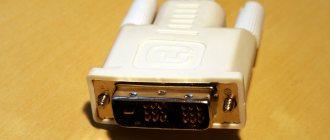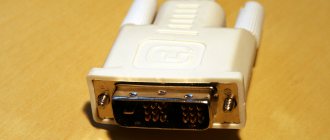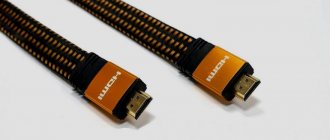What is HDMI interface
TVs, monitors, laptops, media players, system units, and consoles are equipped with an HDMI connector. The interface supports the following resolutions: 1920×1080, 2560×1440, 4K. The advent of HDMI made it possible to significantly increase the functionality of technology. One of the main advantages is the simultaneous transmission of sound and picture, so there is no need to use a large number of different cords.
The abbreviation HDMI stands for High Definition Multimedia Interface. The interface ensures the transmission of digital content with maximum resolution. Audio transmission is carried out through the connector. Content is protected from piracy. This is a step towards fighting piracy.
The interface fully complies with the digital content protection regulations. HDMI has a large number of types and types. All optimized versions have certain improvements. Therefore, the updated connector specifications are a perfect product. An HDMI cable is not always included in the basic package of equipment. It is possible that the user will have to buy the cord separately.
What does an HDMI cable look like? An ordinary cord, the length of which varies in the range of 3-5 meters. There are also longer versions. Manufacturers offer users wires with different sheaths, for example, enhanced protection against mechanical stress. Some versions are equipped with ferrite rings. They prevent interference.
History of HDMI output
The HDMI interface was officially recognized in 2002. Many popular equipment manufacturers worked on the implementation of this connector: Philips, Sony, Toshiba and other brands. Why was the HDMI connector created, since there were other interfaces? The main feature is that this port was 100% digital, and it also provided picture broadcast and sound playback at the same time.
The new connector guaranteed the transmission of content with maximum resolution. One cable replaced several wires at once. The introduction of the new standard has made life easier for users. Today everyone knows what an HDMI connector is and what this port is used for.
How HDMI differs from other outputs
The key difference is the improved transmission speed of the information flow. The cable provides high-definition content. The audio signal is transmitted through 8 channels of 24-bit audio with a frequency of 192 kHz. This indicates high-quality sound. Absolutely all types of HDMI connectors transmit picture and sound simultaneously.
Its predecessors were used to transmit an analog signal, and the popularization of HDMI was marked by the transition to a digital format. Today, users can purchase a cable of any size, which ensures convenient use of equipment.
How does an HDMI cable work?
The cord is formed by several constituent elements:
- protection;
- braid;
- screen made of high quality aluminum;
- polypropylene shell;
- twisted pair of two types;
- elements of control signals and power systems.
Expensive or cheap
Cheap and expensive digital cables are no different in terms of picture and sound quality. Fancy cables from famous brands will not provide improved contrast or saturation of the picture; rather, they will guarantee the absence of problems. Moreover, expensive cables, due to the use of various creative shielding methods, become rigid, difficult to bend and hide from view.
You may encounter digital cords labeled Premium. Does this mean they are somehow better? Partially yes. Premium is a paid certificate issued to the manufacturer. This marking tells us that this wire can operate up to 18 Gbit/s and can cope with the 2.0 standard. But products without this badge of honor also support the specified transmission speed, so there is no need to specifically “chase” for it, but you just need to carefully study the inscriptions on the packaging.
The best idea when choosing an HDMI cable is to buy a regular, simple digital cable, and in case of problems that most likely will not arise, advertise it.
How to check the functionality of a digital cable when purchasing? Follow the instructions:
- check the wire with a cable tester, it can be ordered in the online store;
- inspect the soldering of the connector for any mechanical defects; the color of the metal of the plug should not be different;
- inspect the cord along its entire length - no protrusions or irregularities are allowed;
- study the packaging, it must contain information about the manufacturer and be in a marketable form.
Types of HDMI cables
The interface is classified into types and types in accordance with certain criteria. Let's start with the connector types, there are five of them:
- The leader in popularity is type A, which is also quite often called Full Size. Most often found on GPU modules, laptops, TVs and other devices.
- Type B is designed to transmit content with a high resolution of 3830x2400 pixels, but is practically not used today.
- Smaller version – type C or Mini Size. Mobile devices are equipped with this interface: smartphones, tablets.
- Micro Size is Type D. Another reduced specification of a popular connector that is used on miniature devices.
- Type E is designed for connecting all kinds of equipment to cars. We are talking about radio tape recorders, etc.
We looked at the types of HDMI connectors. As for cables, they are classified as follows:
- standard – provides content transmission with a resolution of up to 720p;
- standard with Ethernet support - similar to the previous type, but equipped with an additional twisted pair cable, which is necessary to connect to the Internet;
- high-speed – used for transmitting 4K content. Has excellent data transfer speed;
- high-speed with Ethernet support – maximum throughput is complemented by the option of connecting equipment to the Internet network;
- automotive – focused on operation in non-standard conditions. Maintains performance at elevated temperatures.
These are the basic classifications of the HDMI cable and connector, but there are also several additional ways to divide the popular interface into versions.
HDMI cable versions
Many versions of the interface have been released between 2002 and 2021. Developers have been actively improving HDMI, improving certain aspects of data transmission. The following cable versions can be purchased on the modern market:
- The very first version, introduced back in 2002, was HDMI 1.0. Used to broadcast content with 1080p resolution and 8-channel audio.
- The emergence of HDMI 1.1 is due to the need to ensure sound protection. The implementation of the necessary solutions made it possible to play DVD audio.
- In order to ensure correct synchronization with computer system units and other equipment, HDMI 1.2 is implemented. The new version also expands the range of readable formats.
- Upgrade through the release of HDMI 1.2a made it possible to expand the protocols to implement an updated remote control system.
- HDMI 1.3 again integrates new formats and eliminates sound loss. Increases color range and throughput.
- Version HDMI 1.3b was created to ensure correct control of household appliances.
- There is a need to play 3D and 4K content; two new versions of HDMI 1.4 and 1.4a are being created specifically for this. A Fast Ethernet Internet connection is also implemented. After a while, version 1.4b appears with an improvement in throughput.
- HDMI 2.0 minimizes level imbalance during data transfer. Improved 4K and 3D support. New methods are emerging for simultaneous transmission of sound and picture.
- The final version was presented in 2021 - HDMI 2.1. The developers have increased the bandwidth and range of supported resolutions for the content being played.
It is also necessary to carefully study the types of connectors.
mini HDMI cable
The main purpose of a mini HDMI cable is synchronization with portable equipment: cameras, video cameras, smartphones, tablets. All these devices are equipped with reduced micro and mini connectors. As for functionality, these cables are no different from the standard version. The only difference is the reduced size, which is an advantage.
A mini HDMI cable connector is also found on some GPU modules. The small dimensions of the interface allow developers to equip the video card with a DVI input. Miniature ports are extremely rare on classic media players and TVs.
HDMI compatibility with other outputs and adapters for them
An HDMI cable can be used to connect equipment that is equipped with older interfaces. This primarily applies to DVI and VGA. However, to connect the cable to the device you will need a special adapter. For example, there are even USB-HDMI adapters on sale. Therefore, today any device can be connected to a TV without any problems. The most popular adapters:
- HDMI-VGA;
- DVI-HDMI;
- USB-HDMI.
Users will not have any difficulties setting up the connection.
What determines the quality of signal transmission via HDMI?
The data transfer speed is specified in the interface and cable specifications. This display is influenced by the length and quality of the cord. Large lengths of wire require a special cross-section using copper conductors. Large diameter is another indicator of high data transfer speed.
Let's assume the cable length is 10 meters and thickness is 8 millimeters. These are good indicators. If the length increases to 15-20 meters, then the thickness should be at least 9-10 millimeters. Improved insulating properties and compliance with operating rules ensure that there is no loss of quality during signal transmission.
Advantages and disadvantages of the HDMI interface
The list of strengths and weaknesses varies depending on the version of the HDMI connector. To summarize, the following advantages can be identified:
- transmission of picture and sound is carried out through 1 cable;
- practicality and ease of use;
- Many types of equipment are equipped with an HDMI interface;
- Data transfer is carried out at maximum speed.
There are practically no disadvantages. If you choose the right thickness and length of the cable, there will be no interference. Therefore, it is necessary to take this point into account in order to ensure high-quality image reproduction.
Relevance of the HDMI interface
The HDMI output has remained in demand for a long period of time. The emergence of new models of technology only helps to maintain the relevance of this interface. Developers are updating the cable and connector, introducing useful additions, for example, support for playing content in maximum resolution.
Many users prefer this interface because it streams audio and video. The presence of a large number of adapters for synchronizing via HDMI equipment with older connectors also helps to maintain relevance.
Maximum length
The length of the wire is one of the main parameters taken into account when making its purchase. Therefore, the route and length of the cord should be thought out in advance.
The maximum permissible length of an HDMI cable cannot exceed 15 meters - this is the recommendation of the HDMI Working Group consortium (with the participation of Hitachi, Panasonic, Philips, Sony, Thomson, Toshiba), which oversees the standard. If your telecommunications infrastructure requires the use of a longer wire, then you will have to resort to so-called signal repeaters or signal regenerators. However, in most cases this problem will not affect you, since devices are rarely more than 2-5 meters away from each other. As an exception, we can only assume a projector placed on the ceiling or at the other end of the room.
Numerous tests have shown that a working digital cord, made of the simplest basic materials, up to 1.5 m long, copes well with transmission. The quality of transmission can only be noticed on fairly long wires and large TV screens, for example, when you need to be able to transmit images using 3D technology or 4K HDR (a new standard that is becoming increasingly popular among gamers) using this wire.
Difference between HDMI and DVI
The predecessor of HDMI is the DVI connector. Surely all users have heard about this output, since it is mainly through it that the system unit is connected to the computer monitor. However, this cable only provides video transmission. Based on this, we can conclude that the main difference is the simultaneous transmission of sound and picture.
The modern port is smaller than DVI. The introduction of HDMI marked the final transition to digital signal transmission. Another important difference is the increased throughput. Despite the high signal transmission speed, there is no loss of quality.
What should you pay attention to when buying an HDMI cable and should you overpay for expensive options?
The user must consider shielding that provides the appropriate level of protection. Consumers are recommended to buy twisted pair cable, since such a cord is characterized by reduced interference. You can avoid interference by purchasing a shielded cable.
Some experts believe that a cord with a gold-plated contact contributes to higher quality of transmitted content. However, this is not an entirely true statement. Gold plating protects the wire from rust.











